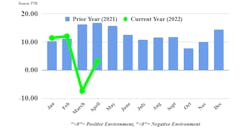FTR’s Trucking Conditions Index (TCI) for April rebounded to a reading of 3.21 from March, when the index fell to -7.38.
However, the April reading otherwise was weak for the pandemic market, as it was the lowest since July 2020 aside from March’s negative reading, FTR added. Diesel prices in April were relatively stable, but softer capacity utilization and freight rates made for positive but lackluster market conditions for trucking companies. The outlook is mildly positive in the near term, but ongoing fuel price increases and other factors could result in further negative readings.
“Recent strong gains in trucking’s payroll employment support our analysis that freight demand has remained solid and that weaker spot market metrics this year indicate a shift of activity back to more normal route guides,” said Avery Vise, FTR’s vice president of trucking. “Driver availability no longer is the key issue to watch in trucking conditions; increasingly, the principal question will be the resilience of freight demand.
“Downside risks are high and growing due to inflation and related stresses, but our forecasting model so far is not identifying a downturn.”
Details of the April TCI are found in the June 2022 issue of FTR’s Trucking Update.
Beyond the TCI and additional commentary, the Update includes data and analysis on load volumes, the capacity environment, rates, and the economy.
The TCI tracks the changes representing five major conditions in the U.S. truck market: Freight volumes, freight rates, fleet capacity, fuel prices, and financing costs. The individual metrics are combined into a single index indicating the industry’s overall health. A positive score represents good, optimistic conditions. Conversely, a negative score represents bad, pessimistic conditions. Readings near zero are consistent with a neutral operating environment, and double-digit readings in either direction suggest significant operating changes are likely.









